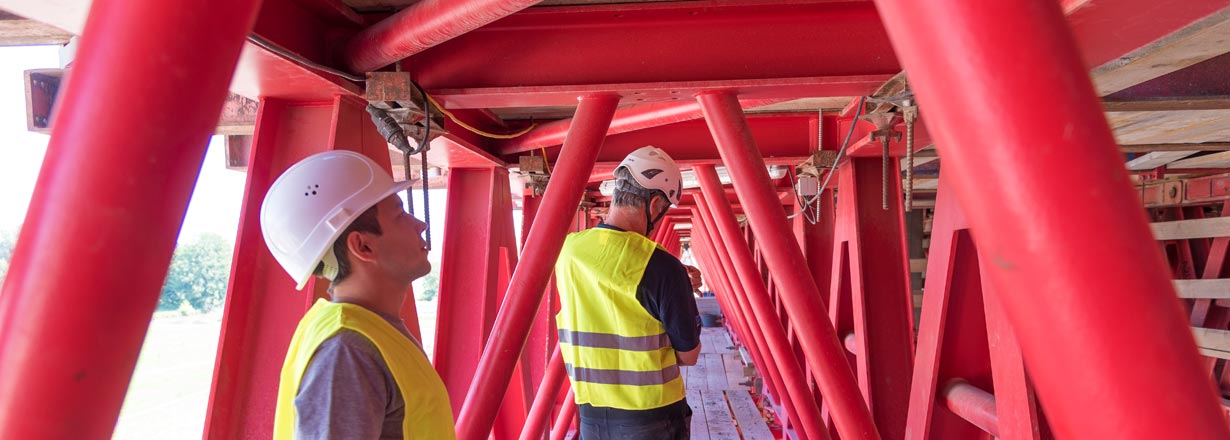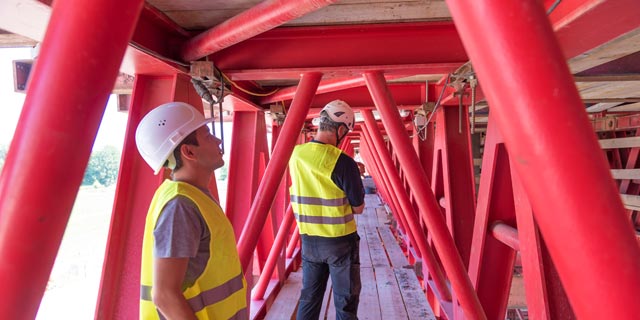– Bundesvereinigung der Prüfingenieure für Bautechnik e.V. (BVPI) – is the consortium of the Regional Associations of Design Review Engineers for structural integrity and fire protection. Within the states of the Federal Republic of Germany.
The head office of the Association ist located in the centre of the German political capital Berlin. That allows short, direct ways to law and code writing organisations to cooperate with policy-makers, public authorities and associations in dealing with general issues and matters relating to design, design review an construction in general.
Design review engineers are experienced professional civil engineers who help to prevent risks in connection with the structural integrity and fire protection of buildings, by providing professional support and supervision.
According to the Four-Eyes-Principle and on behalf of the building authorities design review engineers check for compliance with public law and standardized rules of technology regarding structural design and fire protection. As an authorised contractor, the design review engineer is integrated into the official procedure, acting as a sovereign entity and is subject to the technical supervision of the supreme building control authorities.
The sovereign, preventive design review performed by the design review engineer, has proven to be very successful in Germany with regards to hazard prevention. In addition, it has positive economic outcomes on a private and national level due to the quality assurance associated with it.
The protection of human life and its physical integrity are fundamental human rights and, consequently, a crucial part of a nation's legal framework.
In Germany the legal basis for the work of design review engineers is the state's obligation which stipulations are found in Article 2 (2) of the Basic Law for the Federal Republic of Germany:
(2) Every person shall have the right to life and physical integrity. Freedom of the person shall be inviolable. These rights may be interfered with only pursuant to a law.
In this way, the legislator ensures that risks of damage resulting from failures in structural facilities are kept away from users and the general public. In Germany, this obligation is implemented through the independent design review-system, based on the Four-Eyes-Principle. Design review engineers recognized by the supreme building control authorities perform this sovereign task on behalf of the state.
The construction regulations law defines the technical requirements for individual construction projects. It primarily serves to prevent hazards arising from the construction, existence and use of buildings. The construction regulations law containes provisions stating whether or not and which permission is required for the building project (i.e. setbacks, road development, traffic safety, structural integrity, fire protection and so on).
The legislative power for issuing construction regulations law lies with the individual federal states. These regulate the respective state construction regulations in their federal building codes. In order to allow for the individual building regulation laws to be unified as far as possible across all Federal States, a so called Model Building Regulation Code (Musterbauordnung - MBO) was developed. The MBO serves as a recommendation for adoption by the individual Federal States and is adopted into the Federal State building regulations to a large extent. Part 5 of the Model Building Code, Section 3 (approval procedure) contains a regulation which states that compliance with the requirements for structural integrity, fire protection, sound, thermal insulation and protection against vibration must be proven by structural design verification.
These proofs are called structural design verifications.
For certain (complex) buildings, the structural design verifications relating to structural integrity and fire protection must be certified either by the building inspection authority or by qualified experts. This applies to buildings with a height of more than seven meters, more than two units and more than 400 square meters each. Qualified experts are the Design Review Engineers for structural integrity and for fire protection.
For buildings of building classes 4 and 5, a special design review procedure for structural design verification and for fire protection verification is thus mandatory via section 66 paragraph 3 of the MBO and the respective State Building Act.
The basic principle of the review procedures is that alongside with the client, designer, executor/contractor, and construction manager, another independent party evaluates the structural design verifications relating to structural integrity and fire protection and certifies their correctness and reliability.
This ensures a particularly high level of safety with regards to structural integrity and fire protection of complex buildings.
The legal framework for the professional practice of design review engineers is set down in subordinate regulations. Similar to the Model Building Regulation, the professional regulation of Design Review Engineers is set out in the Model Ordinance on Design Review Engineers and Design Review Consultants (M-PPVO). The M-PPVO, in turn, serves as a recommendation for adoption by the individual federal states, and they generally adopt large parts of the M-PPVO. In addition, however, there are also numerous state-specific regulations.
The content of the M-PPVO is structured as follows:
Section 2 of the M-PPVO regulates the task of the design review engineer. It states that:
The design review engineer is appointed by the building control authorities. He acts like a civil servant in a sovereign position and is subject to the supervisory of the supreme building control authority.
As representatives of the building control authority they have a special liability privilege, which means that in the event of an error being made in the course of their activity they are only liable within the liability of the supreme building control authority.
Section 4 of the M-PPVO defines the general requirements that must be met for a person applying to become a Design Review Engineer. According to this, the requirement is in particular the economically and technically independent work.
BUILDING LAW
„Fundamental principles in German Construction Regulation Law"
General Counsel
Henning Dettmer
Dipl.-Ing. Christian Klein
FIRE PROTECTION
„Construction Law as Basis of Fire Protection Review"
Prof. Dr.-Ing. Sylvia Heilmann
BUILDING AUTHORITY
„Design Review Engineers: The most important support oft the Sovereign Design Review and Inspection"
Dr.-Ing. Gerhard Scheuermann
Design Review Engineers are approved and accredited by the supreme building control authority. Candidates are required to demonstrate their professional qualification in a multistage examination procedure.
Main task of the Design Review Engineer is the independent technical verification of construction projects according to the four-eye principle.
The profound understanding of the responsibility for the safety of the built environment unifies the international community of structural and fire protection design review.
The Design Review by technically and economically independent and chartered Design Review Engineers in combination with a strong building authority has been proven successful in Germany for almost a century.

